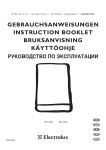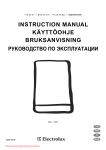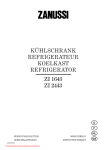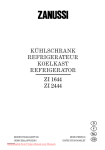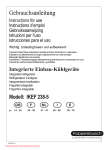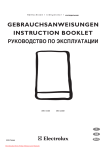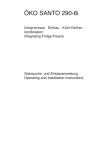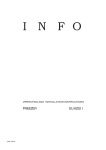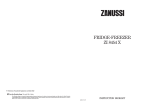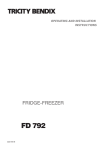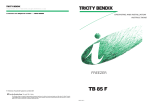Download Electrolux ERN 2930 User manual
Transcript
k ü h l s c h r a n k / r e f r i g e r a t o r / k y l s k å p / j ä ä k a a p p i / хoлoдильник GEBRAUCHSANWEISUNGEN INSTRUCTION BOOKLET BRUKSANVISNING KÄYTTÖOHJE РУКОВОДСТВО ПО ЭКСПЛУАТАЦИИ D ERN 1672 ERN 2372 GB S FIN 2222 751-86 Downloaded from Fridge-Manual.com Manuals RUS Instructions for the use of the instructions booklet t Notes which are important for your safety or for the proper functioning of the appliance Supplementary information regarding operation and practical applications of the appliance. Tips and notes concerning economical and environmentally sound use of the appliance Safety Instructions This information has been provided in the interests of your safety. Please read it before installing or using the appliance. Please retain the instruction book for future reference. If owner ship is transferred, please leave the user manual for the new owner. Domestic Use Child Safety ¥ The domestic refrigerators and freezers are designed to be used specifically for the storage of edible foodstuffs only. ¥ Check the appliance for transport damage. Under no circumstances should a damaged appliance be installed. In the event of damage please contact your retailer. ¥ This appliance is heavy. The edges and projecting parts of the cabinet may be sharp. Be careful when moving the cabinet and always use gloves. ¥ Any electrical work required to install this appliance should be carried out by a qualified electrician or competent person. ¥ Make sure that the power plug is not squashed or damaged by the back of the appliance. Make sure that the cable is not trapped underneath the appliance, nor touches the motor. ¥ Do not remove the power cord by pulling on its lead, particularly when the appliance is being pulled out of its niche. If the power plug socket is loose, do not insert the power plug. Damage to the cord may cause a short-circuit, fire and/or electric shock. ¥ Do not use electrical appliances inside the appliance. ¥ Do not keep carbonated drinks or bottles in the freezer compartment. The glass bottles may break. ¥ Ice lollies can cause Ôfrost/freezer burnsÕ if consumed straight from the freezer. ¥ It is dangerous to try and alter the specifications or modify this product in any way. ¥ Under no circumstances should you attempt to repair the appliance yourself. Refer to your local Service Centre, and always insist on genuine spare parts. ¥ This appliance is designed to be operated by adults only. Do not allow the children to tamper with the controls or play with the products. There is a risk of suffocation! Keep packaging material away from children! Environment Protection ¥ This appliance does not contain gasses which could damage the ozone layer, in either its refrigerant circuit or insulation materials. The appliance shall not be discarded together with the urban refuse and rubbish. Avoid damaging the cooling unit. Information on your local disposal sites may be obtained from your municipal authorities. Remove the plug and ensure that any locks or catches are removed, to prevent young children being trapped inside. Disposal Appliance Packaging Information ¥ The materials marked with the symbol are recyclable. >PE< for polyethylene, e.g. sheet wrapping material >PS< for polystyrene, e.g. padding material (always CFC-free) >POM< polyoxymethylene, e.g. plastic clips. All materials are environmentally sound! Printed on paper manufactured with environmentally sound processes Downloaded from Fridge-Manual.com Manuals 11 Disposal of old appliances The symbol on the product or on its packaging indicates that this product may not be treated as household waste. Instead it shall be handed over to the applicable collection point for the recycling of electrical and electronic equipment. By ensuring this product is disposed of correctly, you will help prevent potential negative consequences for the environment and human health, which could otherwise be caused by inappropriate waste handling of this product. For more detailed information about recycling of this product, please contact your local city office, your household waste disposal service or the shop where you purchased the product. Contents Safety Instructions . . . . . . . . . . . . . . . . . . . . . . . . . . . . . . . . . . . . . . . . . . . . . . . . . . . . . . . . . . . . . . . . . . . . . .11 Disposal . . . . . . . . . . . . . . . . . . . . . . . . . . . . . . . . . . . . . . . . . . . . . . . . . . . . . . . . . . . . . . . . . . . . . . . . . . . . . . .12 Use and Control Before Use / Starting the appliance / Temperatur control . . . . . . . . . . . . . . . . . . . . . . . . . .12 Internal parts / Hints . . . . . . . . . . . . . . . . . . . . . . . . . . . . . . . . . . . . . . . . . . . . . . . . . . . . . . . . . . . . . . . . . . . .13 Maintenance Defrosting / Cleaning / Changing the light bulb . . . . . . . . . . . . . . . . . . . . . . . . . . . . . . . . . . . . .14 Something not Working / Customer Service and Spare Parts / Technical Specifications . . . . . . . . . . . .15 Door reversal . . . . . . . . . . . . . . . . . . . . . . . . . . . . . . . . . . . . . . . . . . . . . . . . . . . . . . . . . . . . . . . . . . . . . . . . . . .16 Installation Positioning . . . . . . . . . . . . . . . . . . . . . . . . . . . . . . . . . . . . . . . . . . . . . . . . . . . . . . . . . . . . . . . . . .16 Electrical connection . . . . . . . . . . . . . . . . . . . . . . . . . . . . . . . . . . . . . . . . . . . . . . . . . . . . . . . . . . . . . . . . . . . .13 Building-in . . . . . . . . . . . . . . . . . . . . . . . . . . . . . . . . . . . . . . . . . . . . . . . . . . . . . . . . . . . . . . . . . . . . . . . . . . . . .17 Use and Control Before Use Wait two hours before connecting the appliance to allow the oil to flow back in the compressor. ¥ Before using the appliance for the first time, wash the interior and all internal accessories with lukewarm water and some neutral soap so as to remove the typical smell of a brand-new product, then dry thoroughly. Do not use detergents or abrasive powders, as these will damage the finish. ¥ Remove safety elements used for transportation. Starting the appliance ¥ Insert the plug into the wall socket and turn the thermostat knob clockwise beyond position ÇOÈ (OFF). ¥ The thermostat control situated inside the fridge compartment regulates the temperature of the appliance. ¥ Turn the thermostat control to the required setting. 12 Downloaded from Fridge-Manual.com Manuals Temperature Control ¥ The following effects are of significance in respect of the interior temperature: ¥ Ambient temperature ¥ Quantity and temperature of the food stored; ¥ Frequency with which the door is opened and how long it is left open ¥ the location of the appliance. ¥ The temperature inside the appliance is automatically adjusted. ¥ Setting ã1Ò = hightest temperature, warmest setting ¥ Setting ã6Ò = lowest temperature, coldest setting. ¥ Setting ã¥Ò = Off A medium setting is generally the most suitable. Internal Parts Storage shelves ¥ The shelves can be removed for cleaning. ¥ To permit storage of food packages of various sizes, the shelves can be placed at different heights. ¥ To remove the internal shelf pull forward until it can be tipped up or down and removed. ¥ Please do the same in reverse to insert the shelf at a different height. D338 ¥ For better use of space, the front half-shelves can lie over the rear ones. The glass shelf above the vegetable drawers and the bottle shelf should always remain in position, to ensure correct air circulation. Door shelves ¥ To permit storage of food packages of various sizes, the central door shelf can be adjusted in height. ¥ Gradually pull the shelf in the direction of the arrows until it comes free, then reposition as required. ¥ For more thorough cleaning, the top and bottom door sheves can be removed by pulling them in the direction of the arrows, then refitting them in position. Hints Saving Energy ¥ Pay careful attention to where the cabinet is placed. See the section ÒInstallationÓ. When installed correctly the cabinet will consume less energy. ¥ Try to avoid keeping the doors open for long periods or opening the doors too frequently as warm air will enter the cabinet and cause the compressor to switch on unnecessarily often. ¥ If the ambient temperature is high, the thermostat knob is on the coldest setting (higher numbers) and the appliance is fully loaded, the compressor may run continuously, causing frost or ice to form on the evaporator. If this happens, turn the knob to a warmer setting (lower numbers) to allow automatic defrosting and so a saving in electricity consumption. ¥ Do not place warm foods inside the appliance. Allow warm foods to cool first. ¥ Keep the heat emitting condenser, the metall grille on the rear wall of your appliance, always clean. Hints for refrigeration ¥ Do not store warm food or evaporating liquids in the refrigerator and do cover or wrap up the food, particularly if it has a strong smell. To help you use your refrigerator correctly, here are some useful hints: ¥ Raw meat (beef, pork, lamb & poultry): wrap in polythene bags and place on top of the salad compartment, this being the coldest spot in the refrigerator. Meat can only be stored safely in this way for one or two days at the most. ¥ Cooked food, cold cuts, jelly, etc.: these should be well covered and can be stored on any of the glass shelves. ¥ Fruit & vegetables: these should be thoroughly cleaned and placed in the bottom drawer/s. ¥ Butter & cheese: these should be placed in special airtight containers or wrapped in aluminium foil or polythene bags to keep out as much air as possible. ¥ Milk bottles: these should have a top and should be stored in the bottle rack on the door. Bananas, potatoes, onions and garlic, if not packed, must not be kept in the refrigerator. 13 Downloaded from Fridge-Manual.com Manuals Maintenance Unplug the appliance before carrying out any maintenance operation. Warning This appliance contains hydrocarbons in its cooling unit maintenance and recharging must therefore only be carried out by authorised technicians. Defrosting ¥ Defrosting the refrigerator compartment is automatic. The defrost water drains out through a trough into a container at the back of the appliance, above the motor compressor, where it evaporates. Cleaning Never use metal objects for cleaning your appliance as it may get damaged. NEVER use detergents, abrasive powders, highly perfumed cleaning products or wax polishes to clean the interior as these will damage the surface and leave a strong odour. Clean the inside with warm water and bicarbonate of soda. Rinse and dry thoroughly. To guarantee a safe operation of the fridge, once a year remove the ventilation grill at the base and clean the air channels with a vacuum cleaner. When the appliance is not in use Disconnect the appliance from the electricity supply. Empty all foods and clean the appliance, leaving the doors ajar to prevent unpleasant smells. Changing the light bulb D037 ¥ It is important to periodically clean the defrost water drain hole. ¥ Should the interior light fail to work, first switch off the appliance and disconnect from the electricity supply, then replace the bulb as follows: 1. unscrew the light cover securing screws. 2. unhook the moving part by pressing it as shown in the figure. 3. Replace the bulb by other with another with the same charcteristics. D411 14 Downloaded from Fridge-Manual.com Manuals Something not Working Problems may be due to causes which can easily be solved before calling the Technical Service. Please follow these instructions: SYMPTOM SOLUTION Door does not close Level properly the appliances if it is not well levelled. Weight surpasses the storage limit of the door shelf so spread weight more evenly or take some products out. The appliance is not properly installed. Please look in the ÒBuilding-inÓ section. It is too warm inside the refrigerator Set a lower temperature. Distribute the food products to allow cold air to circulate around them. Make sure that the door is completely closed and that the insulating strip is complete and clean. The temperature where the cabinet is placed is above normal room temperature. It is too cold inside the refrigerator. Turn the temperature regulator to a warmer setting temporarily. The compressor works continuously. Turn the thermostat knob to a lower number. The temperature where the cabinet is placed is above normal room temperature. Check that the ventilation is sufficient and that the ventilation openings are unobstructed. The cause could be the introduction of large quantities of food and/or frequent opening/closing of the door. There is water inside/outside the refrigerator. Sometimes is normal. During automatic defrosting frost thaws on the cooling plate. Water comes out on the floor. Place the drain hose at the back of the cabinet above the drain bowl. Noises Sometimes this is normal. Temperature control may cause clicking sounds when the system is connected or disconnected. The injected cooling gas may produce a gurgling sound while passing through the tubes. The motor may cause a humming noise and/or slight bumping. The insulation material used has a tendency to slighly increase noise levels, how ever it allows for much better insulation and a lower energy consumption. Customer service and spare parts If you cannot find the remedy for a malfunction in these operating instructions, please contact your dealer or our customer service department and consult the Guarantee card. Selective ordering of replacement parts can save unnecessary travel and costs. For this reason always provide the following appliance information: ¥ Model Name ¥ Model Number (PNC) ¥ Serial Number (S-No.) This information can be found on the rating plate inside the cabenit on the left hand wall. We recommend that you enter this information here, so that it is handy if needed. Technical specifications The technical data is indicated in the rating plate on the left side inside the appliance. 15 Downloaded from Fridge-Manual.com Manuals Door reversal The applianceÕs door has been locked in position for transport by means of pins on both sides. According to the door opening direction, remove relevant pins at the top and at the bottom. Warning! If the ambient temperature is cold (i.e. in Winter), the gasket may not fit perfectly to the cabinet. In that case, wait for the natural fitting of the gasket or accelerate this process by heating up the part involved with a normal hairdrier. A B Installation Take utmost care when handling your appliance so as not to cause any damages to the cooling unit with consequent possible fluid leakages. ¥ During normal operation, the condenser and compressor at the back of the appliance heat up considerably. Always ensure that there is adequate ventilation as a failure to do this will result in component failure and possible food loss. See installation instructions. ¥ Important: if the supply cord is damaged, it must be replaced by a special cord or assembly available from the manufacturer or its service agent. The climate classification can be found on the rating plate, which is located inside the cabinet on the left hand wall. The following table shows which ambient temperature is correct for each climate classification: Climate classification for an ambient temperature of SN +10 to +32¡C N +16 to +32¡C ST +18 to +38¡C T +18 to +43¡C 16 Downloaded from Fridge-Manual.com Manuals 50 mm min. 200 cm ¥ Unpack the cabinet and check that it is in good condition and free of any transport damage. ¥ The appliance must not be located close to radiators or gas cookers. ¥ Avoid prolonged exposure of the appliance to direct sunlight. ¥ For safety reasons, minimum ventilation must be as shown in Fig. Attention: keep ventilation openings clear of obstruction. ¥ It is necessary that the niche is provided with a conduct of venti-lation having the following dimensions: Depth 50 mm Width 540 mm 2 Positioning min. 200 cm D526 2 Electrical connection Before plugging in, ensure that the voltage and frequency shown on the serial number plate correspond to your domestic power supply. Voltage can vary by ±6% of the rated voltage. For operation with different voltages, a suitably sized auto-transformer must be used. Important The appliance must be earthed. The power supply cable plug is provided with a contact for this purpose. If the domestic power supply socket is not earthed. connect the appliance to a separate earth in compliance with current regulations, consulting a specialist technician. The Manufacturer declines all responsibility if the above safety precautions are not observed. This appliance complies with the following E.E.C. Directives: - 87/308 EEC of 2/6/87 relative to radio interference suppression. - 73/23 EEC of 19.2.73 (Low Voltage Directive) and subsequent modifications. - 89/336 EEC of 3.5.89 (Electromagnetic Compatibility Directive) and subsequent modifications. Attention! It must be possible to disconnect the appliance from the mains power supply; the plug must therefore be easily accessible after installation. Building-in Dimensions of the recess ERN 1672 Height of housing Depth of housing Width of housing ERN 2372 880 550 560 540 1225 550 560 mm mm mm 1 50 2 3 D022 2 1 1. Fit the appliance in the niche by making sure that it stands against the interior surface of the unit on the side where the door hinges of the appliances are fitted. Insert the appliance until the upper strip butts up against the unit (1) and make sure that the lower hinge is in line with the surface of the unit (2). PR0 It is necessary that the niche is provided with a conduct of ventilation having the following dimensions: Depth 50 mm Width 540 mm D132 2. Apply joint the sealing strip as shown in figure. 17 Downloaded from Fridge-Manual.com Manuals ca. 50 mm 90° I 21 m m 90° ca. 50 mm 3. Open the door and push the appliance against the side of the kitchen unit opposite to that of appliance hinges. Fasten the appliance with 4 screws (I) provided in the kit included with the appliance. 21 m m 6. Place guide on the inside part of the furniture door, up and down as shown in the figure and mark the position of external holes. After having drilled holes, fix the guide with the screws supplied. Ha D C Hc E B 4. Snap vent grille (B) and hinge cover (E) into position. Apply covers (C-D) on joint cover lugs and into hinge holes. PR33 7. Fix cover (Hc) on guide (Ha) until it clips into place. 8mm Hb Ha Ha Hc Hd PR266 5. Separate parts Ha, Hb, Hc, Hd as shown in the figure. 18 Downloaded from Fridge-Manual.com Manuals PR167 Hb 8. Open the appliance door and the furniture door at 90¡. Insert the small square (Hb) into guide (Ha). Put together the appliance door and the furniture door and mark the holes as indicated in the figure. 8mm K Ha PR167 9. Remove the brackets and mark a distance of 8 mm from the outer edge of the door where the nail must be fitted (K). Hb PR168 10. Place the small square on the guide again and fix it with the screws supplied. Should the lining up of the furniture door be necessary, use the clearance of slots. At the end of operations, it is necessary to check if the door of the furniture closes properly. Hb Hd PR167/1 11. Fix cover (Hd) on the small square (Hb) until it clips into place. 19 Downloaded from Fridge-Manual.com Manuals Electrolux HemProdukter AB 923 631 693 / 923 527 634 S-105 45 Stockholm www.electrolux.se ELECTROLUX HOME PRODUCTS OPERATIONS EUROPE Downloaded from Fridge-Manual.com Manuals











